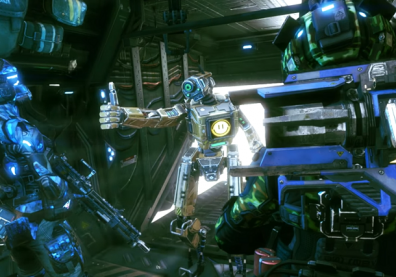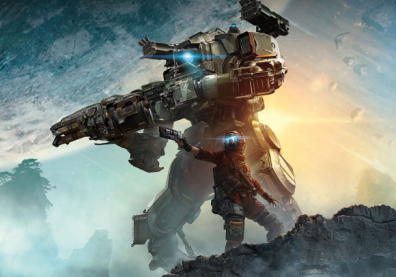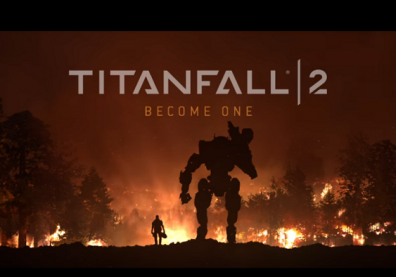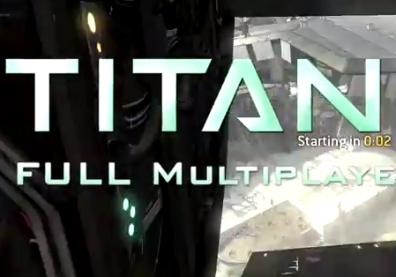As soon as it was announced, Titanfall was one of those games that had an enormous amount of buzz. Maybe it was because the newly formed developer Respawn Entertainment had thrown down the gauntlet against its former employer Activision, seeking to dethrone the publisher's multiplayer king Call of Duty. Or, maybe people just like giant battling robots.
Granted, mechs have been done before, but as far back as I can recall, past mech games just didn't generate this level of interest. MechWarrior felt...clunky. Armored Core was a bit too anime inspired. And Steel Battalion...holy hell, that controller. The thing had a button for the windshield wipers. Immersive, sure, but $200 is a lot to pay for a controller.
Titanfall had appeal from the get-go. Which is interesting, because as the game's director Steve Fukuda writes in the artbook's intro, "Titanfall did not start out as Titanfall. Instead, it started with a simple, yet risky question: 'What game should we make?'" The process of making the game that wound up as Titanfall is what's laid out in this book once the team finally came to a consensus. Not the dry stuff like budget talks, and meeting overviews, but the actual creative process, a look into the imagination of the team with detailed and glossy images of what made it into the final project, and what was unfortunately left on the cutting room floor.
Below for example, a completely different pilot perspective showing the all the bells and whistles of the Titan cabin.
With so much material, this is a whopper of a book, and that's no understatement. This isn't a paperback you bring to the beach. This book is a foot long, and almost as wide. It barely fit on my scanner so I could how you how impressive some of the art work contained therein is.
Fukuda describes it far better than I, writing, "creating something from scratch is never easy. Without some established context and norms, it's difficult to say, 'this belongs, but that doesn't.' Concept art plays an essential role in creating context, enabling our team to discuss context in consistent terms and move forwards. Each piece of art you'll see in this book gives you a glimpse into that process: the distillation of chaos into something new, fun, and relatable."
The book itself starts off with a look at the different classes of the titular mechs (complete with human for scale) for which the game is named, and gives you an appreciation as to how and what about their design earned their namesake, something that you might miss when you're blasting away on the battle field. Images are complete with descriptions from the design team saying how and what gave them inspiration for the crowning achievement of Hammond Robotics.
Close up pictures of the titans let you see the smallest of details, like rust and a tank-style exhaust on the Atlas titan, how the light armor and frailty of the slender "scarecrow" Stryder allows it to be so agile, and more. You can even the how the titans' "toes" are different.
While the titans are the star of the show, they're unfortunately nothing without soldiers to pilot them -- the ragtag Frontier Militia and IMC troops who use the eponymous mechs to slug it out. With Titanfall lacking a traditional campaign mode, it's only on the pages of this book where these characters truly stand out, and you can truly appreciate all the design that went into characters that amount to scurrying ants in play.
As you can see, they aren't just simple palette swaps that designate between factions and/or character types. Lead Artist Joel Emslie describes, "One of our greatest challenges was to make sure that the average player could tell the difference between a grunt and a pilot. We didn't want to make it too obvious, so it was a matter of finding a good balance between player and NPC looks and skins."
Now, onto the good stuff. The weapons.
Both Titans and their pilots have a vast arsenal of highly destructive ordinance to choose from, which have the rare accomplishment of being both futuristic, yet having a nice level familiarity. As noted in the book, "is it comforting or disquieting to learn that future weapons still rely on old-fashioned ballistics?" Maybe, but Titanfall still has its fair share of future weaponry, and everything from pistols, rifles, and launchers new and old are thoroughly dissected.
There's even a breakdown of how ammunition was designed -- the staff spent time "calculating bullet paths and loading sequences to work out the correct bullet trajectory of lethal weapons like the high-tech Smart Pistol."
The bulk of the artbook deals with the various locations where players will be duking it out. Gridiron's Training Ground, the dock yard and skyline of downtown Angel City, the IMF's defensive facility of Outpost 207, Fracture on Yuma System's planet Victor, planets Demeter, Colony, Leviathan's Boneyard, all and more are tremendously detailed in a hundred pages, far too massive to summarize here, and scanning the landscapes just doesn't do them justice.
In my personal opinion though, one of the coolest parts of the book is a closer look at some of the indiginous life forms that inhabit several of Titanfall's Frontier planets. In select maps, you can see see mammoth leviathans stomping around, and dragons will occasionally swoop in to snack on an unlucky grunt or two, but that's about it.
Seen above are several of the aliens in the book once considered for inclusion, and if the rumors are true, what might eventually make their way over to the game in future content. But that's another story...
To sum up, the book itself is a godsend for any and everything that the game never fleshes out quite to your liking. There's no problem with it, but my fear is that its audience is just as limited as that of the game, courtesy of the very nature of Titanfall. The only way possible to play the game is on a Xbox or PC platform, and even then, multiplayer is your only option. That leaves a very specific type of gamer to pick up Respawn's debut, and therein lies the dilemma.
The likelihood of a Wii U or PlayStation console owner picking up the book is very slim, and not to lump people into a group, but it's at least been my experience that the sort of people who frequent the lobbies of multiplayer games aren't the type to have an appreciation for the design work that goes into a game. They play the game to compete, not to oogle at the Frank Lloyd Wright inspired architecture of the buildings on Fracture, or the monolithic skyscrapers of Angel City.
If you have enough humility to admit that you're in this camp, consider this a chance to grab the book and at least try to appreciate what went into the game that was so rabidly anticipated and highly reviewed. Because it's a damn shame for any Titanfall player to miss out on seeing every last drop of artistic talent that went into making this game.









